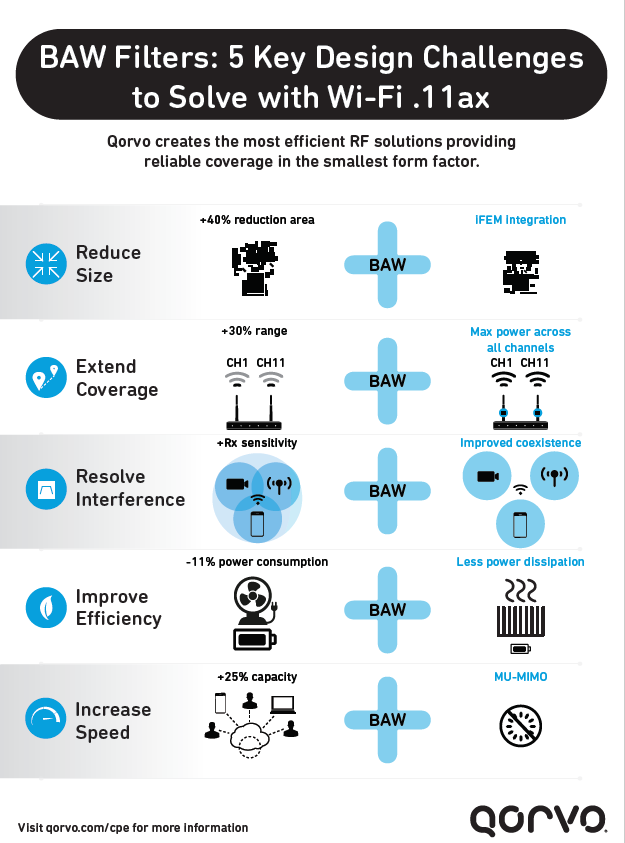In 2019 the Wi-Fi Alliance® plans to release the next generation wireless standard – Wi-Fi 6 (802.11ax). RF component providers, chipset manufacturers and operators are eager and already preparing for the planned update.
When compared to Wi-Fi 5 (.11ac), Wi-Fi 6 provides several major advantages: added speed for faster streaming, increased data capacity for better simultaneous access, and extended coverage for the home and office, which can be further improved using the "mesh" model of a wireless access pod in every room. While Wi-Fi 5 saw some small improvements in data rates compared to its predecessor, it's focus was mainly to improve download speeds. However, in today's more connected world of sharing video and consumer-created content, upload rates are what really need the overhaul. With the implementation of orthogonal frequency division multiple access (OFDMA), Wi-Fi 6 makes use of a successful LTE advancement to greatly reduce network congestion. Instead of holding data channels open until a transmission has finished, with OFDMA channels are subdivided into hundreds of smaller subchannels each using a different frequency. This dicing and stacking of signals provides for an increased speed of 4-10x current rates and a much improved throughput. Now multiple users can upload and download simultaneously without any sacrifice in speeds.
These advantages bring some significant design challenges with them that engineers will need to solve in order to deliver on all of the benefits .11ax has to offer. As with any new standard, working closely with your wireless suppliers and chipset manufacturers can help provide guidance on what components and techniques are best in designing to the specification changes.
Increased connection speeds, extended coverage and longer battery life may well be worth the effort as a strong, reliable Wi-Fi connection is a fundamental necessity for businesses and consumers today. While the promise of Wi-Fi 6 is largely driven by powerful new software protocols, hardware solutions will need to hold up their end of the bargain for this new system to work as planned. When tackling these challenges at the component level, bulk acoustic wave (BAW) filters are ideally suited to address many of the obstacles in designing better hardware for the next-generation 802.11ax wireless standard. Here are a few of the specific use cases for BAW filters and how their improved performance can support new design solutions:
- Resolving interference: One of the main challenges in today's homes is interference. It can come from other devices – like LTE, 5G or IoT devices – and will certainly become an increasing issue in the future as new cell towers are planned to increase 5G network coverage. The main purpose of a BAW filter is to eliminate interference. Using BAW filters inside Wi-Fi access points or products allows the signal to be transmitted in the most efficient way and can improve coexistence between different radio technologies.
- Size reduction: In wireless technology, size matters, especially for operators who want to design small and sleek products for their customers. Reducing size involves designing more efficient boards that position all necessary components within a minimal amount of space. At the Front-End Module (FEM) level this is best accomplished with increased integration. Designing a BAW filter directly into your FEM can reduce board area by up to 40%. This is also a great way to reduce costs by lowering the overall component count.
- Increased speed: Wi-Fi 6 increases data speeds which are key when multiple users connect at the same time to stream 4K UHD videos, attend online conference calls, or play their favorite multi-player role playing game. The Wi-Fi 6 .11ax standard allows the use of more channels simultaneously, and BAW filters aid in this by reducing interference which will help improve data rates.
- Increased efficiency: As Front-End Modules use more channels, temperatures inside the router can increase, which requires more energy efficient components to compensate. BAW filters help reduce power consumption and dissipation by reducing losses in the system and compared to SAW filters, offer a lower loss solution. With a BAW filter, every 0.5 dB improvement results in an 11% gain in efficiency, which leads to less internal heat build-up. More efficient components also allow for smaller form factors as there is less need to include a fan in the design.
With the above considerations in mind, BAW filters can be a design engineer's best friend when used properly to reduce unwanted effects of increased interference or internal device heat. As more customer premise equipment is built to take advantage of the improved capabilities of Wi-Fi 6, keep these benefits in mind, and look to the BAW technology to make your next design go more smoothly!


